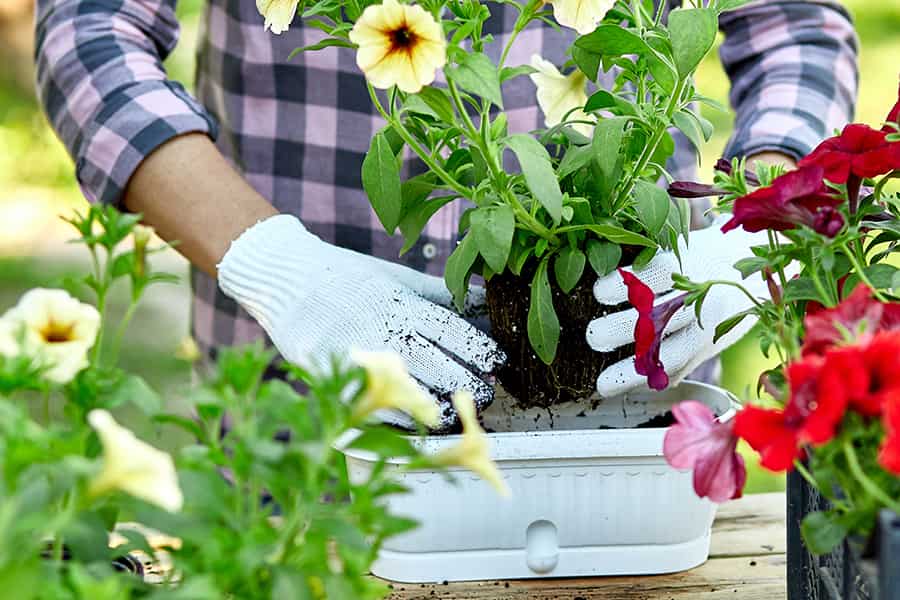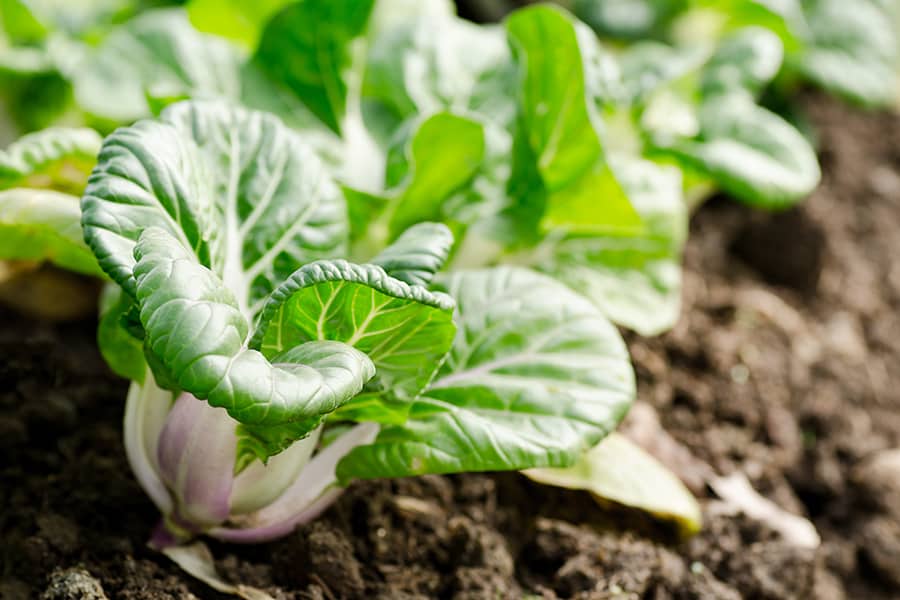June marks the first month of summer – and on 20th of June we’ll also see the longest day of the year. The longer, brighter days will give our gardens an extra boost, so you can expect to see plants have a growth spurt this month.
Gardening jobs for June include continuing the war on weeds, planting out bedding plants, and keeping up with the demands of a thirsty garden.
To help your garden stay in tip-top condition this month, we’ve put together a list of 11 jobs to add to your garden checklist…
1. Harvest peas, broad beans, new potatoes, and strawberries

Early peas (like sugar snap peas), new potato crops, and broad beans should be ready to harvest this month. And, when it comes to peas, the first pickings are often the tastiest!
New potato harvests will need to be dug up – though, because they’re a smaller variety of potato, you might want to leave them in the ground for longer for a slightly larger crop. However, it’s best not to leave them in the ground for more than two or three weeks past their harvest date, or they may spoil.
Broad beans should be picked from the base of the plant with a gentle twisting motion to prevent damage to the stem. Strawberries will usually be juicy and ripe this month too – and throughout the rest of summer.
If you’ve been growing gooseberries, underripe ones can now be picked to use in baking, or for sauces and jams. For ripe ones, it’s best to wait to pick them in July.
To find out which other fruit and veg are best harvested in June, you might want to read this guidance from Love The Garden.
2. Thin fruit trees

The practice of ‘thinning’ fruit trees (removing excess fruit) can be a helpful way to improve the size and quality of fruit. When fruit trees are too crowded, the fruit will compete for space and often end up being smaller in size (and potentially not as tasty).
Fruit thinning is usually carried out on heavy fruits like apples, pears, plums, peaches, and nectarines. For example, apples should be reduced to one fruit per cluster, with clusters being spaced 15-23cm apart. Meanwhile, pears should be reduced to two fruits per cluster, spaced 10-15cm apart.
Peaches will usually grow better if they’re spaced 10cm apart when they’re hazelnut-sized, and 20-25cm apart when they’re walnut-sized.
For more tips and advice on how to thin fruit trees (including nectarines, plums, and apricots) check out this advice from Grow Veg.
3. Keep plants watered

As temperatures rise in June, soil will dry out quickly (particularly in pots and containers), so it’s important to make sure that you’re watering plants regularly.
Once a day should be enough, though if you notice the soil is drying out very quickly, you might need to up your watering to twice daily.
It’s best to water your plants either first thing in the morning and/or late at night – rather than during the hottest part of the day. Watering plants when it’s cooler will allow for maximum absorption, and prevent water from evaporating before it has a chance to penetrate the soil. Be sure to give plants a good soaking for at least 20 seconds.
If your lawn is looking a little dry, try not to worry about this too much, as lawns are durable and will recover quickly when it rains. However, it’s best to avoid wear and tear on dry lawns, as it won’t take long before bald patches start to appear!
Note: To help save water, you could collect rainwater in buckets and use it to water plants on dry days. Bath water can also be used!
4. Pinch out tomato plants

By ‘pinching out’ young tomato plants when they’re four to six inches tall, you can encourage tall, upright growth.
To ‘pinch out’ means to remove the small shoots that are growing at a 45-degree angle in between the plant’s main stem and it’s branches. Have a watch of the video below to see how this is done.
5. Hoe weeds on dry days

It’s important to be on the lookout for pesky weeds this month, as they’ll be competing with your plants for space and light. To reduce the likelihood of weeds growing back, it’s best to hoe them on dry days.
Even if your soil looks weed-free, it’s worth hoeing the soil anyway so that you can interrupt any small seedlings yet to make their appearance above ground.
Gardeners’ World has some useful tips on hoeing methods that you might find helpful.
6. Plant out bedding plants

Bedding plants grow quickly and can create fantastic, colourful displays. And now that the risk of frost has passed, it’s safe to plant them outside in pots or borders.
Petunias, cosmos, and fuschias are popular summer bedding plant options, and are available to purchase on Crocus’ website*, or at your nearest garden centre.
There are certain things that you can do to improve the quality of the blooms, such as…
Planting them in good quality compost. Multi-purpose compost is usually a good option and can be ordered from Amazon*.
Weekly feeds. For best results, use a fertiliser that contains high amounts of potassium – such as tomato feed*.
Protecting them from slugs or choosing bedding plants that are slug resistant – such as snapdragons, begonias, and geraniums. If your garden is particularly prone to slugs, you might want to avoid marigolds, as slugs love them!
Regular deadheading to keep plants flowering throughout the summer.
If you don’t fancy adding bedding plants to your garden, perhaps you’d prefer to sow some flower seeds instead. For a late show of summer colour, consider sowing calendula*, iberis* (candytufts), or clarkia* seeds.
7. Sow pak choi, broccoli, and spring onions

Pak choi* can be sown directly into the ground from June, and will be ready to harvest on a cut-and-come-again basis after just 30 days.
The term cut-and-come-again simply means that after the outer leaves are cut, they’ll sprout again and provide you with a continuous crop. This leafy plant is hardier than many other leafy greens, so late sowings can still produce crops in autumn and winter if protected from frost.
Sowing spring onions* now will make sure that you have fresh crops throughout autumn. They’re a great vegetable to grow on a window sill too, as they have very shallow roots and don’t need much growing space. Other salad crops that can be sown this month include beetroot and lettuce.
Broccoli* (late sprouting cultivars and calabrese) sown now will also be ready to harvest in autumn and winter. For best results, try to avoid planting seeds in very exposed spots where they’ll be more prone to wind-rock.
To find out what else can be sown in June, including French beans, runner beans, and swede, check out our sowing and planting calendar, here.
8. Stake floppy plants

If you haven’t yet staked plants (like sunflowers) that are set to get particularly tall or that’ll have heavy flowers or fruits hanging from their branches, it’s worth doing so this month.
Staking is the act of adding a support to your plant’s stem or branches to help it stay upright. This can help to prevent plants and young trees from snapping or growing off to one side.
Bamboo stakes* are a great go-to for plants that have a single stem. Generally, the cane needs to be about two thirds higher than the height that the plant will eventually reach. Trees, shrubs, and roses might need sturdier wooden stakes*.
For more tips on staking plants, check out this page from Gardeners’ World.
9. Prune early-flowering shrubs

Shrubs that flower in spring or early summer could benefit from some pruning this month to stimulate strong, healthy, new growth and encourage beautiful blooms next year. Examples of early-flowering shrubs include kolkwitzia, weigela, deutzia, and philadelphus.
Early-flowering shrubs usually produce flowers on last year’s growth. So pruning them this month (and removing old flowers) should allow enough time for new shoots to develop throughout the summer and autumn – ready to produce new flowers next year.
To learn how to prune early flowering shrubs, you might want to watch the video from the RHS below.
10. Consider adding flowering plants to your vegetable patch

Professional gardeners often add flowering plants to their vegetable gardens to increase their yield and produce healthier crops.
The main benefit of adding flowering plants to the borders of your veggie garden is that they attract insects to pollinate crops. Plus, they create a nice ornamental effect.
However, there are certain things to consider before mixing flowers with veggies to make sure that they help rather than hinder. For example, it’s important to think about the height of the flowers you’re planting, and whether they’re likely to compete with your veggies for sunlight. On the other hand, crops like cabbages enjoy a bit of shade, so it really depends on your garden needs.
To get more tips on how to mix flowering plants with vegetable crops, check out this article from Good Housekeeping. Or, to learn about the best bee-friendly plants, read this helpful guide from Gardeners’ World.
11. Give greenhouses some shade

While greenhouses help keep plants warm, if temperatures build up too much (usually more than 27C), there’s a chance that plants could become damaged. For this reason, it’s a good idea to make sure that you give your greenhouse some shade during the hottest months of the year.
One of the easiest ways to do this is to add some shade paint* to the glass panels – which can be layered up to add more shade and brushed off when the weather cools down again.
Other methods, such as making sure your greenhouse is well-ventilated and damping down the inside to raise humidity levels, can also help plants cope with heat when there’s more moisture in the air.
For more tips and tricks on keeping your greenhouse cool, have a read of this article from Grow Veg.
Final thoughts...
If you want to get stuck into gardening this month but you’re not sure where to start, we hope this article has helped to give you a few ideas. Alternatively, head over to the gardening section of our website for more inspiration.
Do you have any additional tips that you’d like to share? We’d love to hear from you in the comments below!